Comprehensive Report: Adult Learners' Use of Different Learning Styles
VerifiedAdded on 2023/05/30
|8
|1279
|303
Report
AI Summary
This report provides an overview of different learning styles in adult education. It begins with an introduction to learning styles, defining how individuals perceive, store, and process information. The report then delves into three primary learning styles: visual, auditory, and kinesthetic. For each style, the report explains its usage, pros, and cons. Visual learners benefit from seeing images and written materials, while auditory learners learn best through listening and discussion. Kinesthetic learners prefer hands-on activities and physical experiences. The report concludes by emphasizing the importance of recognizing and accommodating these diverse learning styles to create effective and engaging learning environments for adults. The report includes a table of contents, executive summary, introduction, discussions, and conclusion, supported by references to relevant academic literature.
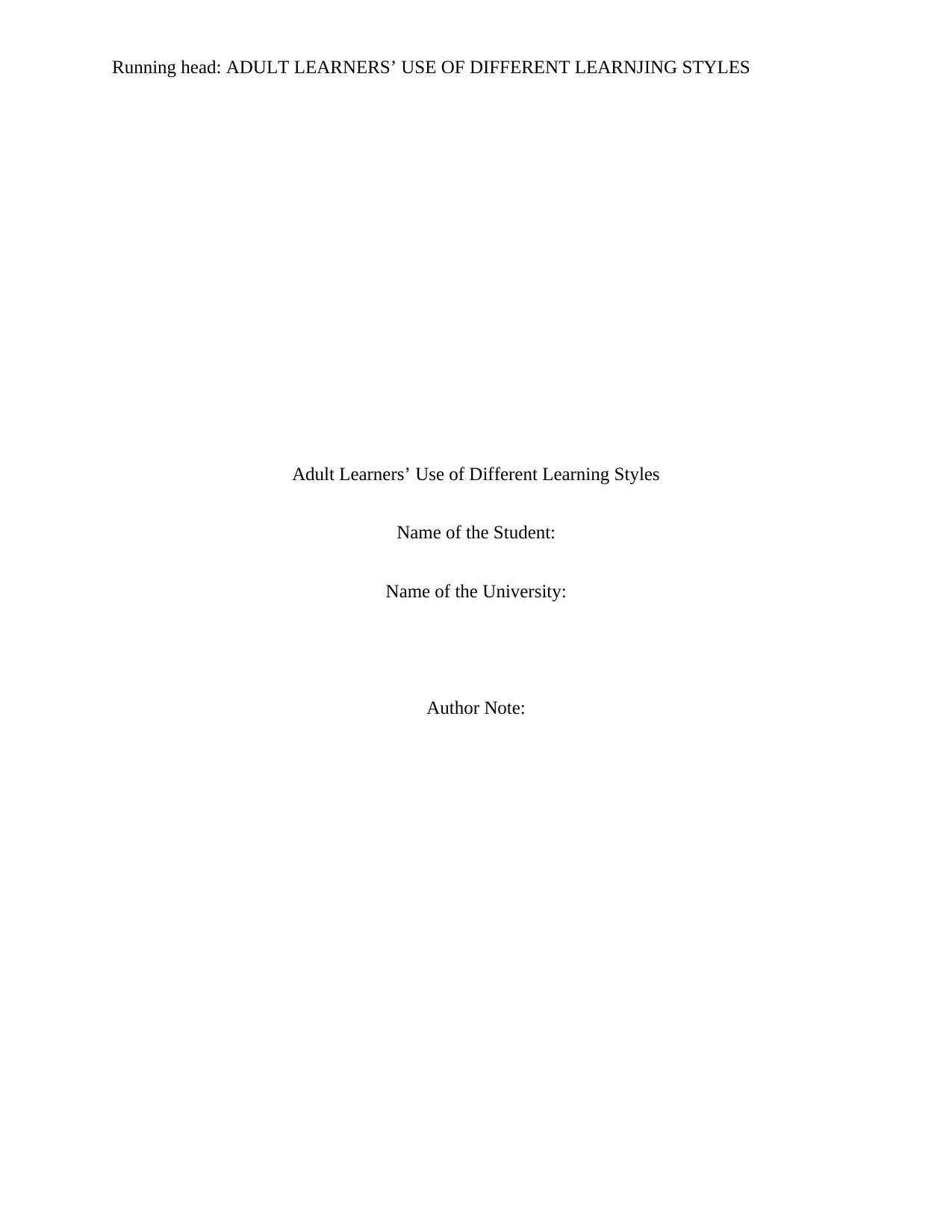
Running head: ADULT LEARNERS’ USE OF DIFFERENT LEARNJING STYLES
Adult Learners’ Use of Different Learning Styles
Name of the Student:
Name of the University:
Author Note:
Adult Learners’ Use of Different Learning Styles
Name of the Student:
Name of the University:
Author Note:
Paraphrase This Document
Need a fresh take? Get an instant paraphrase of this document with our AI Paraphraser
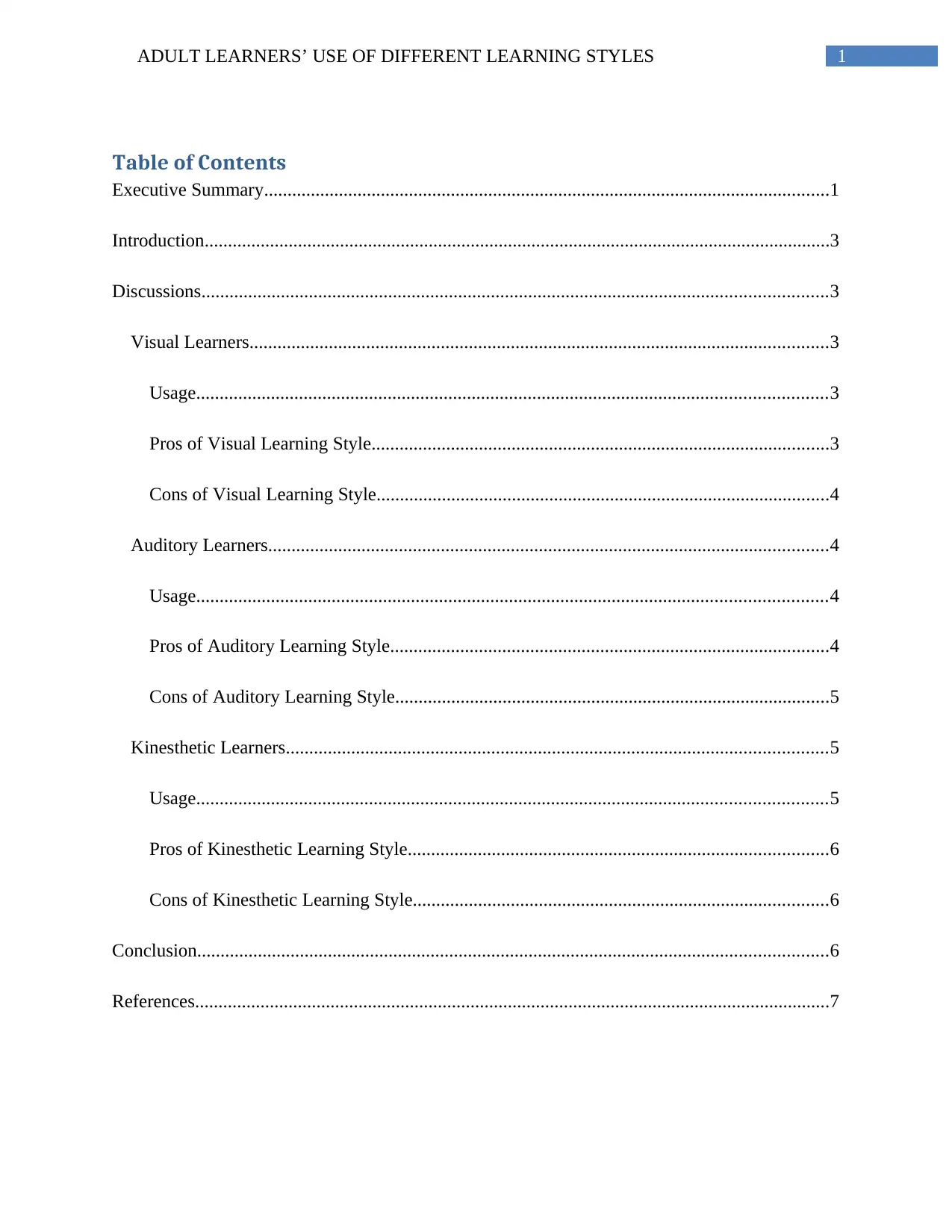
1ADULT LEARNERS’ USE OF DIFFERENT LEARNING STYLES
Table of Contents
Executive Summary.........................................................................................................................1
Introduction......................................................................................................................................3
Discussions......................................................................................................................................3
Visual Learners............................................................................................................................3
Usage.......................................................................................................................................3
Pros of Visual Learning Style..................................................................................................3
Cons of Visual Learning Style.................................................................................................4
Auditory Learners........................................................................................................................4
Usage.......................................................................................................................................4
Pros of Auditory Learning Style..............................................................................................4
Cons of Auditory Learning Style.............................................................................................5
Kinesthetic Learners....................................................................................................................5
Usage.......................................................................................................................................5
Pros of Kinesthetic Learning Style..........................................................................................6
Cons of Kinesthetic Learning Style.........................................................................................6
Conclusion.......................................................................................................................................6
References........................................................................................................................................7
Table of Contents
Executive Summary.........................................................................................................................1
Introduction......................................................................................................................................3
Discussions......................................................................................................................................3
Visual Learners............................................................................................................................3
Usage.......................................................................................................................................3
Pros of Visual Learning Style..................................................................................................3
Cons of Visual Learning Style.................................................................................................4
Auditory Learners........................................................................................................................4
Usage.......................................................................................................................................4
Pros of Auditory Learning Style..............................................................................................4
Cons of Auditory Learning Style.............................................................................................5
Kinesthetic Learners....................................................................................................................5
Usage.......................................................................................................................................5
Pros of Kinesthetic Learning Style..........................................................................................6
Cons of Kinesthetic Learning Style.........................................................................................6
Conclusion.......................................................................................................................................6
References........................................................................................................................................7

2ADULT LEARNERS’ USE OF DIFFERENT LEARNING STYLES
⊘ This is a preview!⊘
Do you want full access?
Subscribe today to unlock all pages.

Trusted by 1+ million students worldwide
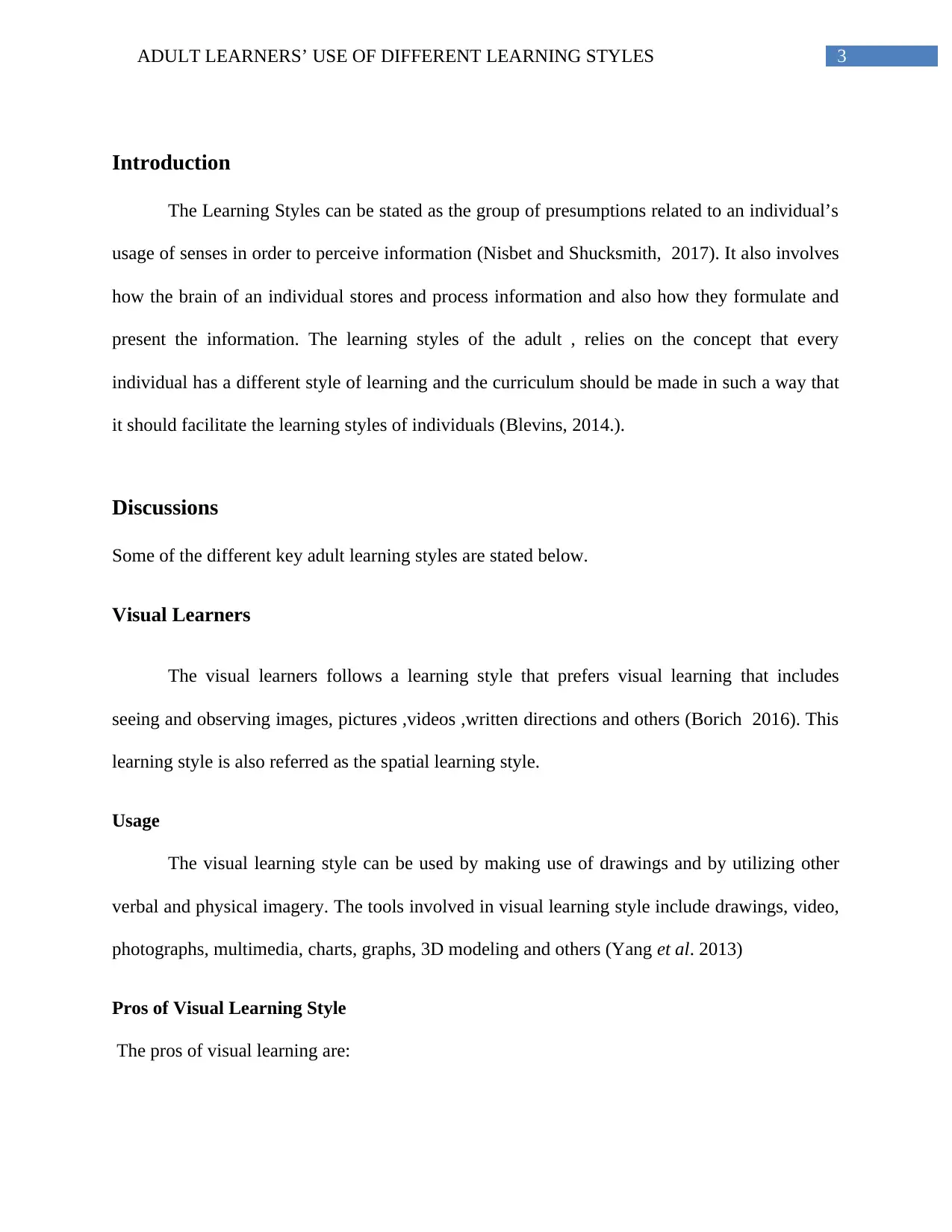
3ADULT LEARNERS’ USE OF DIFFERENT LEARNING STYLES
Introduction
The Learning Styles can be stated as the group of presumptions related to an individual’s
usage of senses in order to perceive information (Nisbet and Shucksmith, 2017). It also involves
how the brain of an individual stores and process information and also how they formulate and
present the information. The learning styles of the adult , relies on the concept that every
individual has a different style of learning and the curriculum should be made in such a way that
it should facilitate the learning styles of individuals (Blevins, 2014.).
Discussions
Some of the different key adult learning styles are stated below.
Visual Learners
The visual learners follows a learning style that prefers visual learning that includes
seeing and observing images, pictures ,videos ,written directions and others (Borich 2016). This
learning style is also referred as the spatial learning style.
Usage
The visual learning style can be used by making use of drawings and by utilizing other
verbal and physical imagery. The tools involved in visual learning style include drawings, video,
photographs, multimedia, charts, graphs, 3D modeling and others (Yang et al. 2013)
Pros of Visual Learning Style
The pros of visual learning are:
Introduction
The Learning Styles can be stated as the group of presumptions related to an individual’s
usage of senses in order to perceive information (Nisbet and Shucksmith, 2017). It also involves
how the brain of an individual stores and process information and also how they formulate and
present the information. The learning styles of the adult , relies on the concept that every
individual has a different style of learning and the curriculum should be made in such a way that
it should facilitate the learning styles of individuals (Blevins, 2014.).
Discussions
Some of the different key adult learning styles are stated below.
Visual Learners
The visual learners follows a learning style that prefers visual learning that includes
seeing and observing images, pictures ,videos ,written directions and others (Borich 2016). This
learning style is also referred as the spatial learning style.
Usage
The visual learning style can be used by making use of drawings and by utilizing other
verbal and physical imagery. The tools involved in visual learning style include drawings, video,
photographs, multimedia, charts, graphs, 3D modeling and others (Yang et al. 2013)
Pros of Visual Learning Style
The pros of visual learning are:
Paraphrase This Document
Need a fresh take? Get an instant paraphrase of this document with our AI Paraphraser
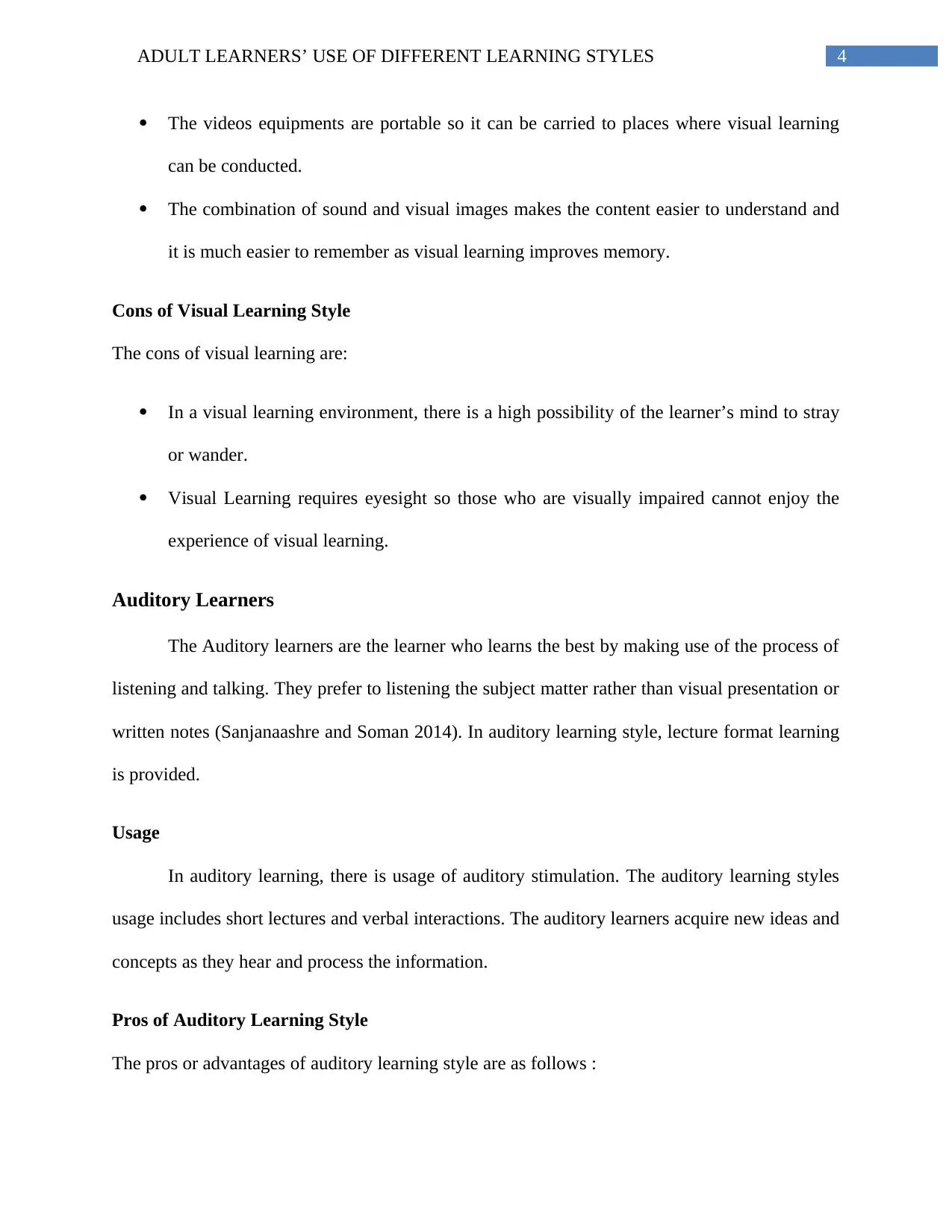
4ADULT LEARNERS’ USE OF DIFFERENT LEARNING STYLES
The videos equipments are portable so it can be carried to places where visual learning
can be conducted.
The combination of sound and visual images makes the content easier to understand and
it is much easier to remember as visual learning improves memory.
Cons of Visual Learning Style
The cons of visual learning are:
In a visual learning environment, there is a high possibility of the learner’s mind to stray
or wander.
Visual Learning requires eyesight so those who are visually impaired cannot enjoy the
experience of visual learning.
Auditory Learners
The Auditory learners are the learner who learns the best by making use of the process of
listening and talking. They prefer to listening the subject matter rather than visual presentation or
written notes (Sanjanaashre and Soman 2014). In auditory learning style, lecture format learning
is provided.
Usage
In auditory learning, there is usage of auditory stimulation. The auditory learning styles
usage includes short lectures and verbal interactions. The auditory learners acquire new ideas and
concepts as they hear and process the information.
Pros of Auditory Learning Style
The pros or advantages of auditory learning style are as follows :
The videos equipments are portable so it can be carried to places where visual learning
can be conducted.
The combination of sound and visual images makes the content easier to understand and
it is much easier to remember as visual learning improves memory.
Cons of Visual Learning Style
The cons of visual learning are:
In a visual learning environment, there is a high possibility of the learner’s mind to stray
or wander.
Visual Learning requires eyesight so those who are visually impaired cannot enjoy the
experience of visual learning.
Auditory Learners
The Auditory learners are the learner who learns the best by making use of the process of
listening and talking. They prefer to listening the subject matter rather than visual presentation or
written notes (Sanjanaashre and Soman 2014). In auditory learning style, lecture format learning
is provided.
Usage
In auditory learning, there is usage of auditory stimulation. The auditory learning styles
usage includes short lectures and verbal interactions. The auditory learners acquire new ideas and
concepts as they hear and process the information.
Pros of Auditory Learning Style
The pros or advantages of auditory learning style are as follows :
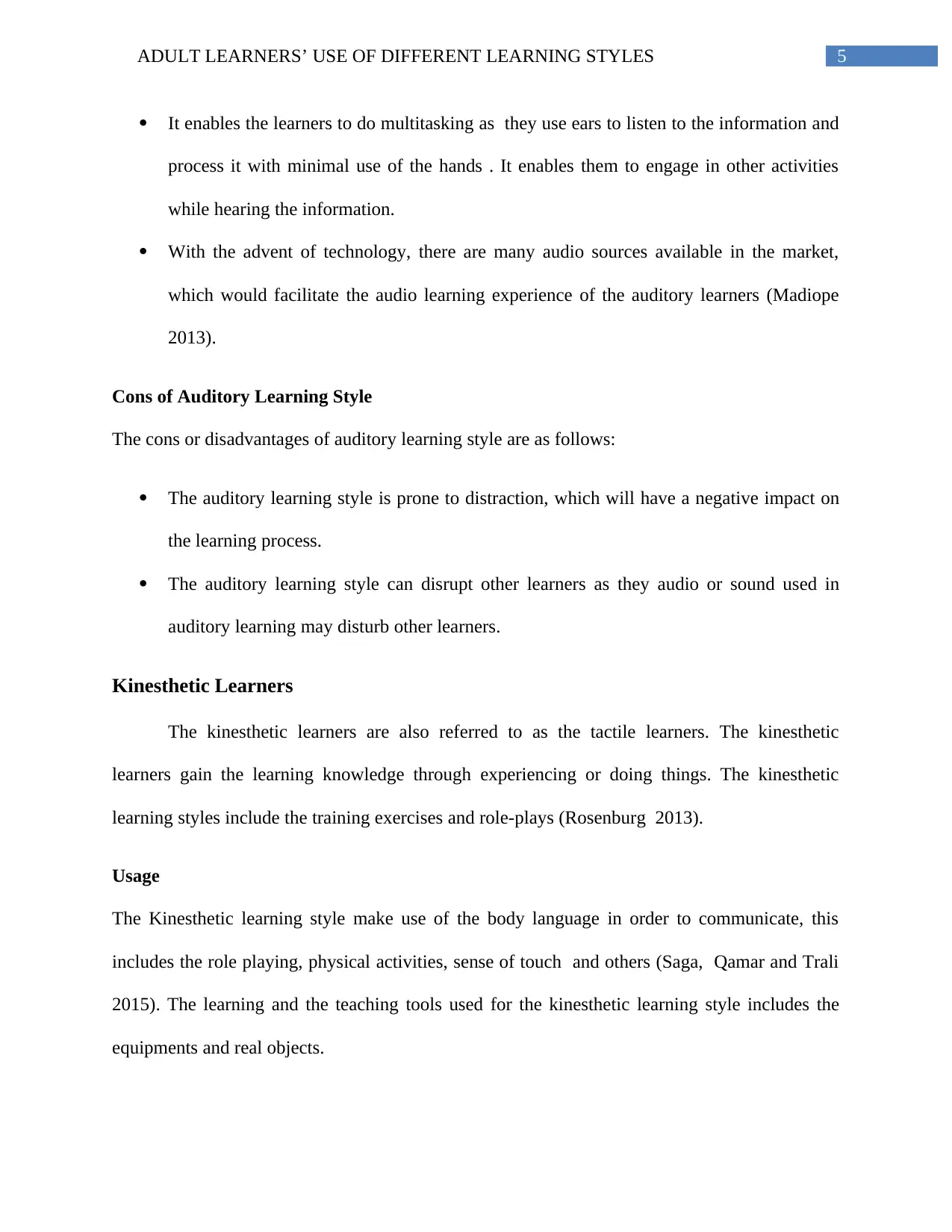
5ADULT LEARNERS’ USE OF DIFFERENT LEARNING STYLES
It enables the learners to do multitasking as they use ears to listen to the information and
process it with minimal use of the hands . It enables them to engage in other activities
while hearing the information.
With the advent of technology, there are many audio sources available in the market,
which would facilitate the audio learning experience of the auditory learners (Madiope
2013).
Cons of Auditory Learning Style
The cons or disadvantages of auditory learning style are as follows:
The auditory learning style is prone to distraction, which will have a negative impact on
the learning process.
The auditory learning style can disrupt other learners as they audio or sound used in
auditory learning may disturb other learners.
Kinesthetic Learners
The kinesthetic learners are also referred to as the tactile learners. The kinesthetic
learners gain the learning knowledge through experiencing or doing things. The kinesthetic
learning styles include the training exercises and role-plays (Rosenburg 2013).
Usage
The Kinesthetic learning style make use of the body language in order to communicate, this
includes the role playing, physical activities, sense of touch and others (Saga, Qamar and Trali
2015). The learning and the teaching tools used for the kinesthetic learning style includes the
equipments and real objects.
It enables the learners to do multitasking as they use ears to listen to the information and
process it with minimal use of the hands . It enables them to engage in other activities
while hearing the information.
With the advent of technology, there are many audio sources available in the market,
which would facilitate the audio learning experience of the auditory learners (Madiope
2013).
Cons of Auditory Learning Style
The cons or disadvantages of auditory learning style are as follows:
The auditory learning style is prone to distraction, which will have a negative impact on
the learning process.
The auditory learning style can disrupt other learners as they audio or sound used in
auditory learning may disturb other learners.
Kinesthetic Learners
The kinesthetic learners are also referred to as the tactile learners. The kinesthetic
learners gain the learning knowledge through experiencing or doing things. The kinesthetic
learning styles include the training exercises and role-plays (Rosenburg 2013).
Usage
The Kinesthetic learning style make use of the body language in order to communicate, this
includes the role playing, physical activities, sense of touch and others (Saga, Qamar and Trali
2015). The learning and the teaching tools used for the kinesthetic learning style includes the
equipments and real objects.
⊘ This is a preview!⊘
Do you want full access?
Subscribe today to unlock all pages.

Trusted by 1+ million students worldwide
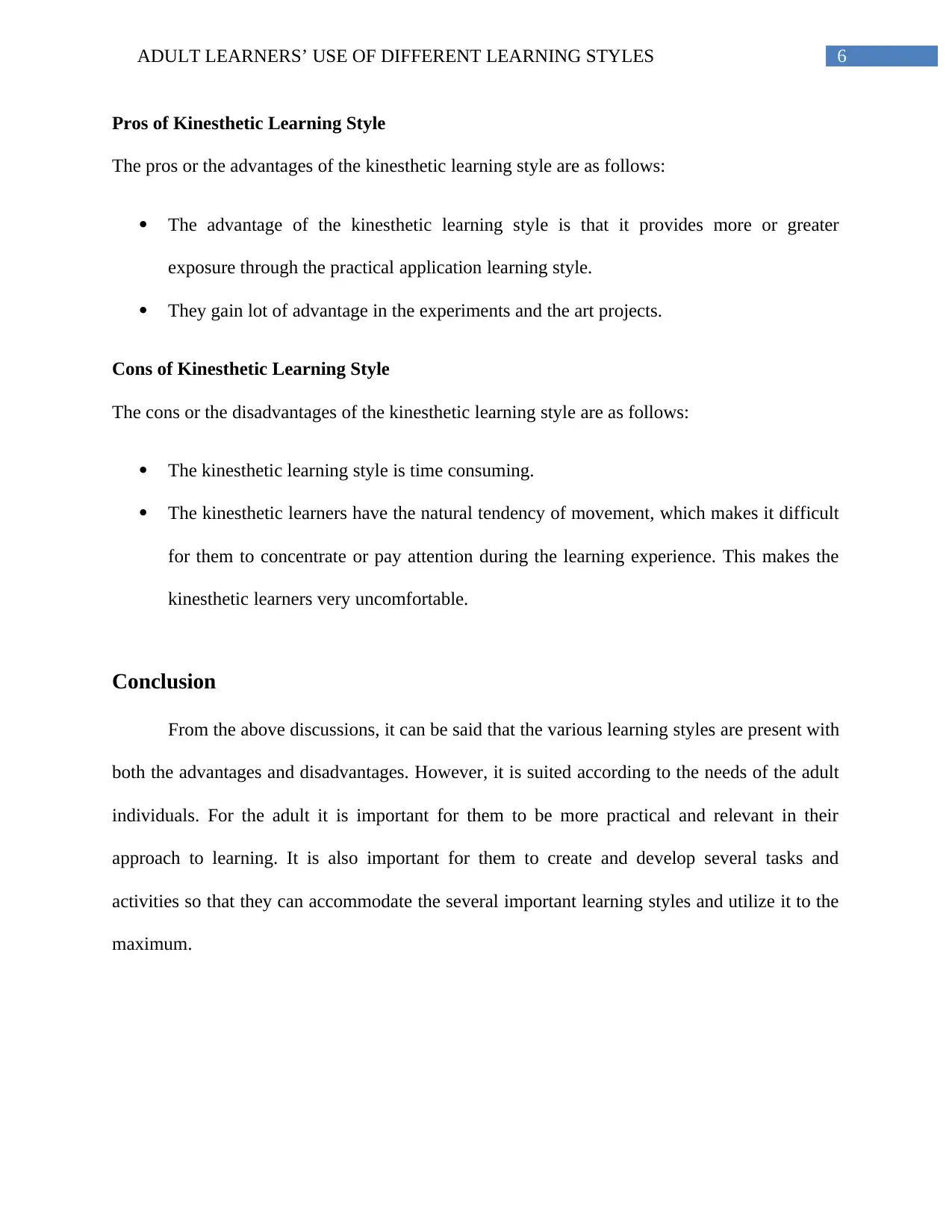
6ADULT LEARNERS’ USE OF DIFFERENT LEARNING STYLES
Pros of Kinesthetic Learning Style
The pros or the advantages of the kinesthetic learning style are as follows:
The advantage of the kinesthetic learning style is that it provides more or greater
exposure through the practical application learning style.
They gain lot of advantage in the experiments and the art projects.
Cons of Kinesthetic Learning Style
The cons or the disadvantages of the kinesthetic learning style are as follows:
The kinesthetic learning style is time consuming.
The kinesthetic learners have the natural tendency of movement, which makes it difficult
for them to concentrate or pay attention during the learning experience. This makes the
kinesthetic learners very uncomfortable.
Conclusion
From the above discussions, it can be said that the various learning styles are present with
both the advantages and disadvantages. However, it is suited according to the needs of the adult
individuals. For the adult it is important for them to be more practical and relevant in their
approach to learning. It is also important for them to create and develop several tasks and
activities so that they can accommodate the several important learning styles and utilize it to the
maximum.
Pros of Kinesthetic Learning Style
The pros or the advantages of the kinesthetic learning style are as follows:
The advantage of the kinesthetic learning style is that it provides more or greater
exposure through the practical application learning style.
They gain lot of advantage in the experiments and the art projects.
Cons of Kinesthetic Learning Style
The cons or the disadvantages of the kinesthetic learning style are as follows:
The kinesthetic learning style is time consuming.
The kinesthetic learners have the natural tendency of movement, which makes it difficult
for them to concentrate or pay attention during the learning experience. This makes the
kinesthetic learners very uncomfortable.
Conclusion
From the above discussions, it can be said that the various learning styles are present with
both the advantages and disadvantages. However, it is suited according to the needs of the adult
individuals. For the adult it is important for them to be more practical and relevant in their
approach to learning. It is also important for them to create and develop several tasks and
activities so that they can accommodate the several important learning styles and utilize it to the
maximum.
Paraphrase This Document
Need a fresh take? Get an instant paraphrase of this document with our AI Paraphraser
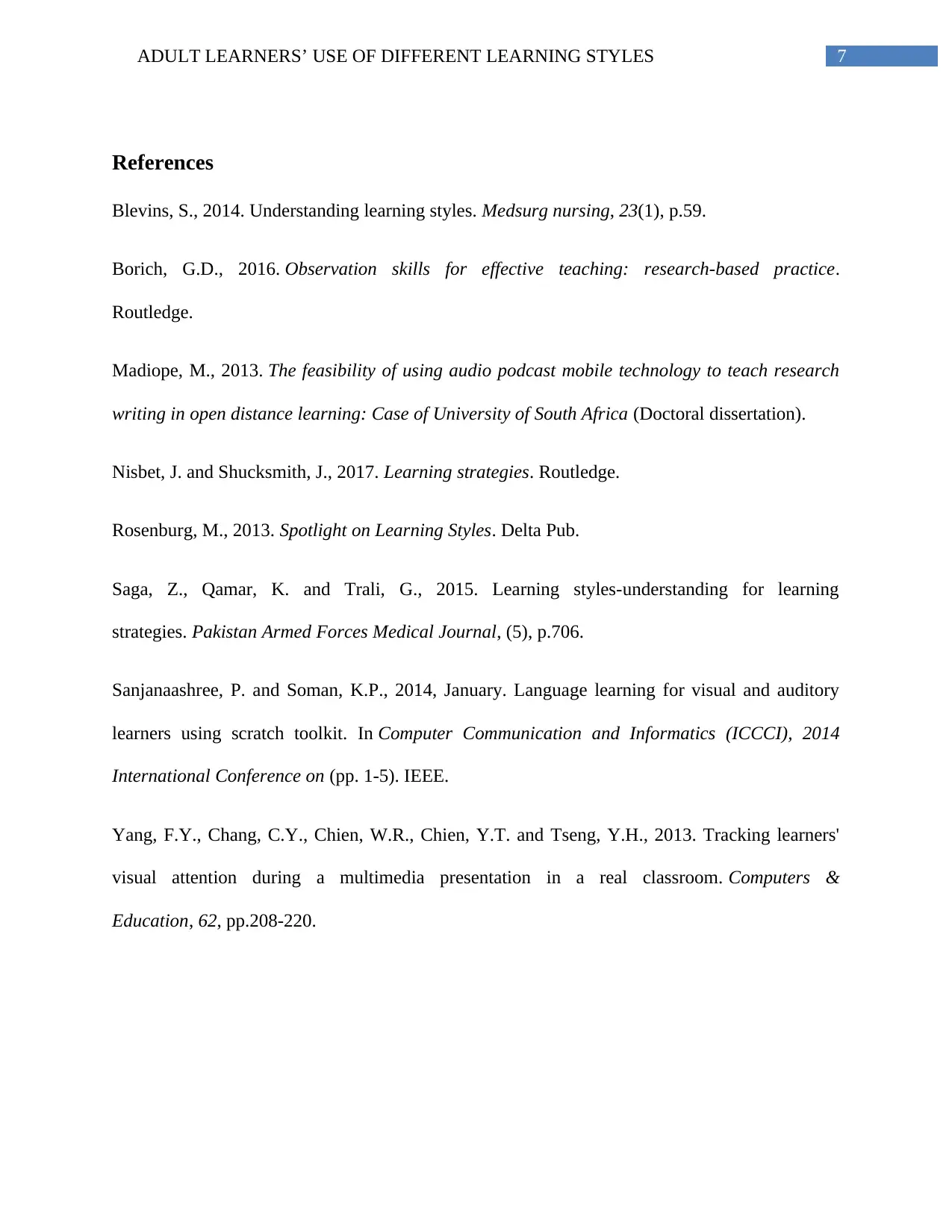
7ADULT LEARNERS’ USE OF DIFFERENT LEARNING STYLES
References
Blevins, S., 2014. Understanding learning styles. Medsurg nursing, 23(1), p.59.
Borich, G.D., 2016. Observation skills for effective teaching: research-based practice.
Routledge.
Madiope, M., 2013. The feasibility of using audio podcast mobile technology to teach research
writing in open distance learning: Case of University of South Africa (Doctoral dissertation).
Nisbet, J. and Shucksmith, J., 2017. Learning strategies. Routledge.
Rosenburg, M., 2013. Spotlight on Learning Styles. Delta Pub.
Saga, Z., Qamar, K. and Trali, G., 2015. Learning styles-understanding for learning
strategies. Pakistan Armed Forces Medical Journal, (5), p.706.
Sanjanaashree, P. and Soman, K.P., 2014, January. Language learning for visual and auditory
learners using scratch toolkit. In Computer Communication and Informatics (ICCCI), 2014
International Conference on (pp. 1-5). IEEE.
Yang, F.Y., Chang, C.Y., Chien, W.R., Chien, Y.T. and Tseng, Y.H., 2013. Tracking learners'
visual attention during a multimedia presentation in a real classroom. Computers &
Education, 62, pp.208-220.
References
Blevins, S., 2014. Understanding learning styles. Medsurg nursing, 23(1), p.59.
Borich, G.D., 2016. Observation skills for effective teaching: research-based practice.
Routledge.
Madiope, M., 2013. The feasibility of using audio podcast mobile technology to teach research
writing in open distance learning: Case of University of South Africa (Doctoral dissertation).
Nisbet, J. and Shucksmith, J., 2017. Learning strategies. Routledge.
Rosenburg, M., 2013. Spotlight on Learning Styles. Delta Pub.
Saga, Z., Qamar, K. and Trali, G., 2015. Learning styles-understanding for learning
strategies. Pakistan Armed Forces Medical Journal, (5), p.706.
Sanjanaashree, P. and Soman, K.P., 2014, January. Language learning for visual and auditory
learners using scratch toolkit. In Computer Communication and Informatics (ICCCI), 2014
International Conference on (pp. 1-5). IEEE.
Yang, F.Y., Chang, C.Y., Chien, W.R., Chien, Y.T. and Tseng, Y.H., 2013. Tracking learners'
visual attention during a multimedia presentation in a real classroom. Computers &
Education, 62, pp.208-220.
1 out of 8
Related Documents
Your All-in-One AI-Powered Toolkit for Academic Success.
+13062052269
info@desklib.com
Available 24*7 on WhatsApp / Email
![[object Object]](/_next/static/media/star-bottom.7253800d.svg)
Unlock your academic potential
Copyright © 2020–2025 A2Z Services. All Rights Reserved. Developed and managed by ZUCOL.





